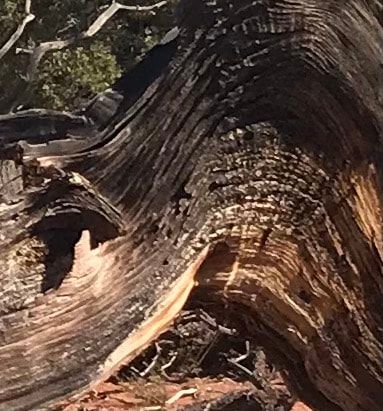 B.Magraw "The Shape of my Juniper" We all have scars---both physical and emotional—sometimes both at the same time. The upside to scars is they can teach us to care for ourselves and others. The downside is they can create heaviness of muscle and spirit, narrowing our options in ways that inhibit enjoyment and fulfillment. In my book I compare scar tissue to PTSD. One of main things they have in common is the energy of contraction. We tend to hide our scars (both physical and emotional), feel trapped, give up a full life and give up our power of choice in the face of our scars. What can we do to expand through our scars and transmute the obstacle (scar tissue,PTSD) into a stepping stone?
I believe the first step is seeing the shape of the scar. What does this mean? On a physical level it means really looking at it-- which is often difficult because we don’t want to feel the loss and grief that go with any major scar (sometimes even small scars). Seeing the shape implies a willingness to experience the grief. We can’t jump over our scars though often we try and develop many odd postures to avoid them. Two metaphors have helped me in dealing with my many scars. One was the idea of ‘stretching the envelope’ What this meant was not trying to deny my limitations but rather to keep moving forwards and outwards in a gradual and realistic manner. This required developing patience with my body. The other was “putting in the crying time” This meant actual hours of active crying were necessary to soften the defensiveness around the scars so they could be their true shape not distorted by compensations of muscle or habit. I found after a thorough grieving process it was much easier to stretch that extra inch or have patience with a strengthening program. I also found that crying helped me to be present with the scars and allow healers to touch and stretch them. Of course it is important that the crying is in service of expansion not contraction. Safety and connection can help with this. An emotional scar often presents as a limiting belief or habit. Much like scar tissue, these beliefs need to be challenged gently, with love and self acceptance. Often part of the shape of an emotional scar is its root (childhood or ancestral). Injured, the root cannot grow a strong plant. If the root is healed the plant will grow stronger—even much later in life. Coming out of emotional hiding can be a long journey but the rewards of seeing the shape of our emotional truth are great. Whether the scar is physical or emotional, in dealing with it we become the shape we were meant to be. Perhaps our attitude can even shift to appreciation for our body/mind and what it went through. Perhaps a scar can be a badge of courage that spurs us on.
0 Comments
Leave a Reply. |
AuthorKristi Magraw is known for having developed a unique synthesis of Eastern healing (Five Element theory) and Western ways of working with the mind, called the Magraw Method, which she established in 1979. This method uses metaphoric language and release techniques to help people heal physical and emotional pain. Archives
September 2023
Categories |
 RSS Feed
RSS Feed
